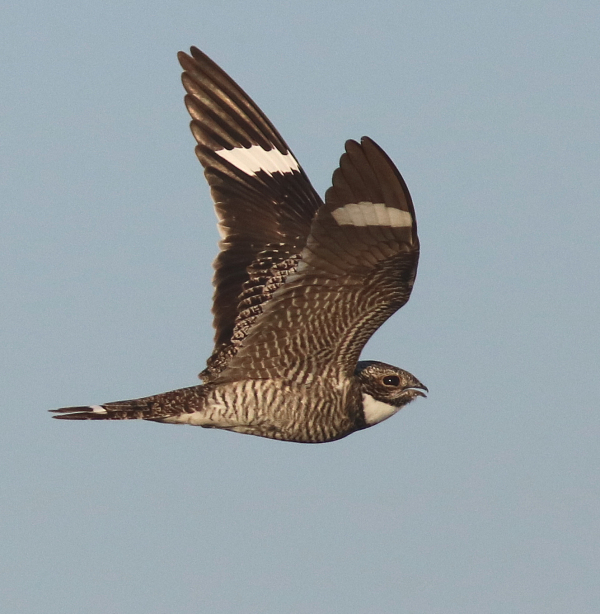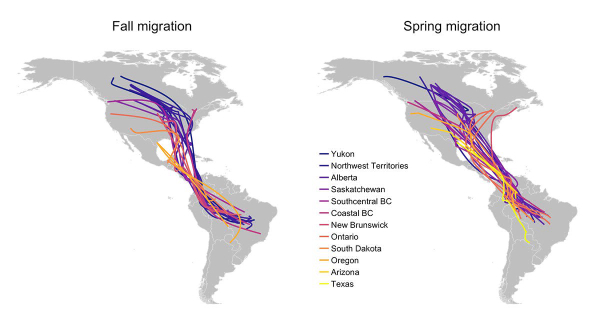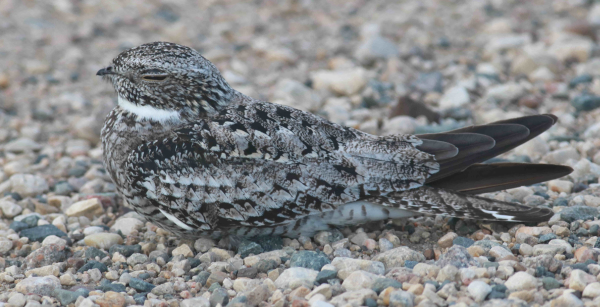
Common Nighthawks primarily migrate to Brazil during North America’s winter season (photo by Paul Konrad).

Maps showing the migration routes of Common Nighthawks during fall (left) and spring (right).

Common Nighthawks are especially had to find when they are not in flight, owing to their cryptically colored plumage (photo by Paul Konrad).
|
A new cooperative research project conducted by representatives of several organizations helped to attach new miniature GPS-satellite tags on 52 Common Nighthawks at 13 locations across the species’ expansive nesting range to better understand where these birds spend their time throughout the year. The study provided insights about their ecology, especially during winter and migration periods. Common Nighthawks are one of the Western Hemisphere’s most widespread migratory species, yet we know little about them after they leave their nesting sites.
The study was initiated by the Migratory Connectivity Project at the Smithsonian Migratory Bird Center, and co-led with the department of Environment and Climate Change Canada and the University of Alberta. Their new research publication has just been released this month in the scientific journal Ecography. Recent estimates indicate that Common Nighthawks have declined by more than 50 percent during the past 40 years. Nighthawks are aerial insectivores – birds that catch insects in flight – a group that is declining faster than any other group of birds in Canada.
The study quickly revealed that the winter destination for all 13 nesting populations studied is the Amazon Basin and Cerrado biomes of South America, mostly within the border of Brazil. Most surprising was the route the representatives took to get to Brazil. All the nighthawks being tracked from nesting areas across North America congregated along the southeast United States before migrating across the Gulf of Mexico and Caribbean to South America.
This concentration toward a common migration route was so strong that one Common Nighthawk from Sydney Island, off the Pacific coast of British Columbia flew 2,000 miles due east over the Rocky Mountains before turning south to migrate in similar fashion to other nighthawks from across Canada, including the Yukon, and western states including Oregon, Arizona, and South Dakota. During spring, each nighthawk migrated north with the combined migration route shifting farther west in more direct routes to their nesting territories.
While the details of the Common Nighthawk migrations and wintering sites are fascinating, one could argue that the question of “why nighthawk populations have declined” is even more important. Understanding their migratory connectivity - the degree to which birds from a particular population stick together throughout the year – is an important first step in the conservation of migratory birds. This information allows biologists to begin to determine places and times of year where threats to populations are likely taking place. To that end, the researchers have taken a novel comprehensive approach to use the nighthawk data to develop an understanding of their migratory connectivity, in both space and time.
Overall, the researchers observed an increase in migratory connectivity (individuals from different populations staying together throughout the year) during the nesting season, during fall migration in North America, and during spring migration prior to crossing the Gulf of Mexico. During their wintering period, nighthawks from different nesting populations mixed with one another in Central and South America. These differences may help explain why different populations of nighthawks are showing different population trends; and the next step is to study the regional variation in population declines to understand more about regional movements.
This article was based on a publication by Elly Knight and Stu Mackenzie that is available on the Birds Canada website at https://www.birdscanada.org/where-do-all-the-nighthawks-go/
The new research publication can be accessed in the scientific journal Ecography at https://onlinelibrary.wiley.com/doi/full/10.1111/ecog.05111
Share your birding experiences and photos at editorstbw2@gmail.com